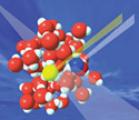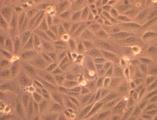Panoramic images are captivating in any form, with their wide field of view and extremely high resolution. Now, SSRL scientists have demonstrated a new x-ray holographic technique for imaging wide areas of a nanoscale sample without losing resolution. The results were published in the November 2007 edition of the journal Optics Letters.
Approximately 1,700 scientists visit SSRL annually to conduct experiments in broad disciplines including life sciences, materials, environmental science, and accelerator physics. Science highlights featured here and in our monthly newsletter, Headlines, increase the visibility of user science as well as the important contribution of SSRL in facilitating basic and applied scientific research. Many of these scientific highlights have been included in reports to funding agencies and have been picked up by other media. Users are strongly encouraged to contact us when exciting results are about to be published. We can work with users and the SLAC Office of Communication to develop the story and to communicate user research findings to a much broader audience. Visit SSRL Publications for a list of the hundreds of SSRL-related scientific papers published annually. Contact us to add your most recent publications to this collection.
Using SSRL's beam line 5-4, researchers from Fudan University in Shanghai and SSRL have worked out the mechanism behind the formation of charge density waves in 2H-structured transition metal dichalcogenides (2H-TMD's). The results were published in the November 21, 2007 edition of Physical Review Letters.
The traditional picture of how liquid water behaves on a molecular level is wrong, according to new experimental evidence collected by a collaboration of researchers from the Department of Energy's Stanford Linear Accelerator Center (SLAC) in California, RIKEN SPring-8 synchrotron and Hiroshima University in Japan and Stockholm University in Sweden. The team, involving SLAC scientist Anders Nilsson, used advanced X-ray spectroscopy techniques to create a more detailed picture of water's molecular behavior. The results are published as the cover story in the July 30, 2008 edition of the journal Chemical Physics Letters.
Researchers working in part at SSRL Beam Lines 8-1 and 10-1 recently characterized the band offsets in a promising semiconductor material that could lead to smaller and faster electronic devices of the future. The results are published in the September 13, 2007 edition of Applied Physics Letters.
Using SSRL Beam Lines 11-3 and 10-1, a team of researchers including SSRL scientists Mike Toney and Jan Lüning (now at Université Pierre et Marie Curie), and Stanford University researchers, graduate students, Quan Yuan and Mingle Tang, postdoc Stefan Mannsfeld and Prof. Zhenan Bao, have determined the precise arrangement of molecules within a thin film sample of an organic semiconductor, a step that could soon help scientists better design these materials. The results appear in the March 19, 2008 issue of the Journal of the American Chemical Society.
Sulfur is essential for life, playing important roles in metabolism and protein structure and function. Although information on sulfur biochemistry is highly desirable, it is an element that is difficult to study as it is not easily accessible with most biophysical techniques. However, sulfur x-ray absorption spectroscopy (XAS) is one such method and has become increasingly used for the study of sulfur in biological systems. Recently, a group of researchers from Stanford University, the University of Saskatchewan, SSRL, and ExxonMobil used SSRL's Beam Line 6-2 for an in situ sulfur XAS study of living mammalian cell cultures.
TGF-beta is the founding member of a large family of biological molecules important in regulating cellular growth and differentiation, both in embryos as well as adults. Now, using x-ray diffraction at SSRL Beam Line 11-1 for macromolecular crystallography, Groppe, Hinck, and colleagues from the University of Texas Health Science Center at San Antonio have determined the structure of TGF-beta in complex with two of its cellular receptors, a finding that could lead to new insight as to how it functions as a suppressor of cell growth and as a stimulator of cell differentiation, processes which go awry in diseases such as cancer. The results are published in the February 1 edition of Molecular Cell.
The process of melting has long been of interest to scientists. In the case of indium antimonide (InSb), a semiconductor often used to study such processes, the first steps in melting take a few hundred femtoseconds, a quadrillionth of a second. But until recently, no one knew what happened after the initial stages of a phase transition.
Stanford University School of Medicine scientists working in part at SSRL's Beam Line 11-1 have uncovered new molecular insights to the mechanism behind immune disorders such as asthma. Using protein x-ray crystallography at 3.0 Angstrom resolution, researchers Sherry LaPorte and Chris Garcia solved three structures of two signaling proteins known as "cytokines" in complex with their shared receptors, where these molecules help regulate immune system activity. The study was published as the cover story in the January 25 edition of the journal Cell.
Halogenated natural products play important roles as antibiotics, antifungals, and antitumor agents. The process of halogenation involves the replacement of a hydrogen with a halide (such as chloride or bromide), and is a challenging task for a synthetic chemist. However, the iron-containing enzymes in the haloperoxidase and halogenase families readily catalyze these reactions. It is thought that when this reaction occurs, the iron in the enzyme is at a high-valent Fe(IV) state, and that this species is responsible for removing a hydrogen atom (called an abstraction) from the substrate, creating a substrate radical, and that a halogen radical is subsequently transferred to the substrate to complete the halogenation reaction.





![Figure 1: Chemical structure of tetraceno[2,3-b]thiophene (thiotetracene). Figure 1.](https://www-ssrl.slac.stanford.edu/content/sites/default/files/styles/custom-160/public/images/science/highlights/2008/otft_fig1.jpg?itok=YBcdqJKq)








